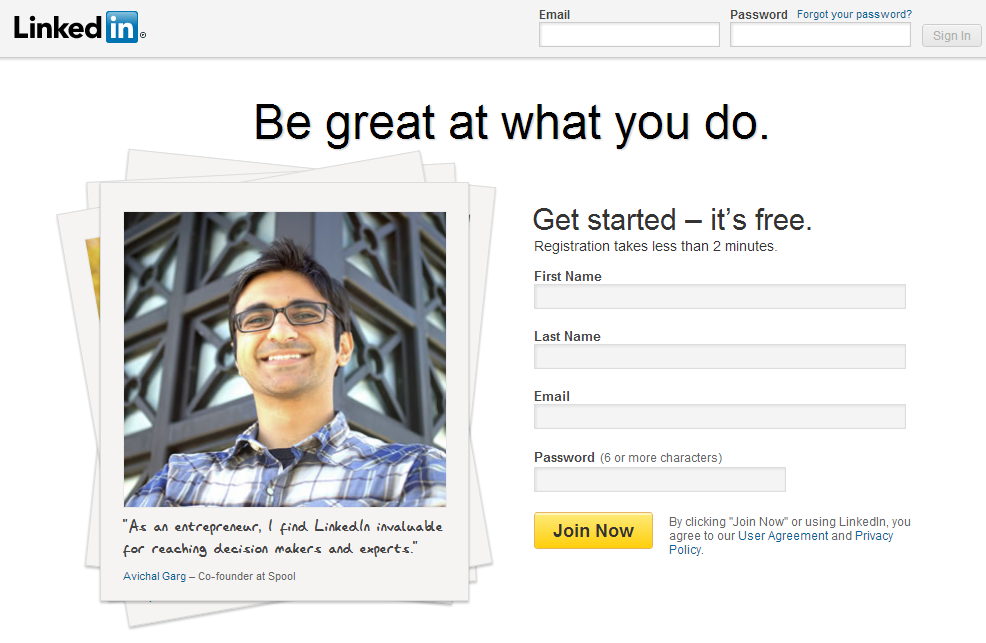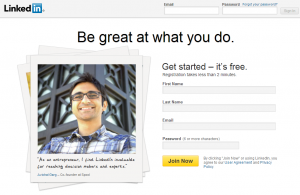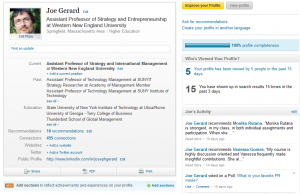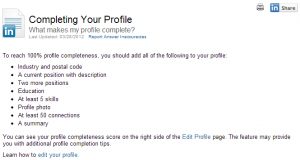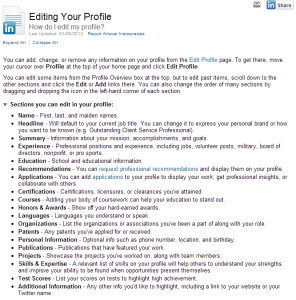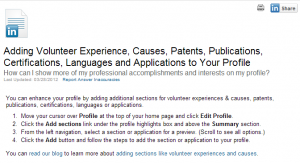HETL Note: We are pleased to present the feature article “LinkedIn® Professional Social Networking System Adoption: Essential Instructor Support for Student Professional Networking and Identity Antecedents“ contributed by Dr. J. G. Gerard who is an expert in supporting innovation and entrepreneurship in developing models for teaching and learning in the digital world. The article discusses in depth how students may be supported to manage their professional identity management and develop skills in maintaining complex professional networks. LinkedIn® is used as the basis for the recommendations provided; the reader may benefit from the systematic review of the phases and steps involved in developing a LinkedIn® professional profile. You may submit your own article on the topic or you may submit a “letter to the editor” of less than 500 words (see the Submissions page on this portal for submission requirements).
 Author Bio: Joseph G. Gerard is an Assistant Professor in the College of Business at Western New England University, U.S.A. He was introduced to learning theory and its application early in his career and has since written a number of peer reviewed articles focused on learning design and educational technology use including Journal of Management Education, International Journal of Academic Research in Business and Social Sciences, and Journal of Educational Technology. He collaborates heavily with instructional designers (IDs) and believes in the ongoing consulting of ID professionals in course design and revision. At present Professor Gerard teaches Strategic Management, International Management, and Entrepreneurship. He otherwise engages in student advisement and other support, varied community service and committee work, and research in both educational technology as well as knowledge-based competition. Gerard can be contacted at [email protected]
Author Bio: Joseph G. Gerard is an Assistant Professor in the College of Business at Western New England University, U.S.A. He was introduced to learning theory and its application early in his career and has since written a number of peer reviewed articles focused on learning design and educational technology use including Journal of Management Education, International Journal of Academic Research in Business and Social Sciences, and Journal of Educational Technology. He collaborates heavily with instructional designers (IDs) and believes in the ongoing consulting of ID professionals in course design and revision. At present Professor Gerard teaches Strategic Management, International Management, and Entrepreneurship. He otherwise engages in student advisement and other support, varied community service and committee work, and research in both educational technology as well as knowledge-based competition. Gerard can be contacted at [email protected]
Krassie Petrova and Patrick Blessinger
~~~~~~~~~~~~~~~~~~~~~~~~~
Essential Instructor Support for Student Professional Networking and Identity Creation: Application and Example within the LinkedIn System
Joseph G. Gerard
Western New England University, U.S.A
Abstract
The excitement that accompanies new technologies like LinkedIn® can distract users from acquiring rudimentary skills needed to effectively use those technologies. This paper argues that student professional networking and identity management are two such skills. One of the greatest benefits to the use of LinkedIn® or other social networking technology in the classroom is that students and instructors learn how to best leverage the network’s value and express students’ professional worth. However, students tend to lack professional networking experience and often have trouble clearly describing their professional identity to others. Therefore, instructors must develop learning experiences that provide students with ample opportunity to define and articulate their professional value and better understand career paths particular to their identity within their selected field.
Keywords: professional identity, professional networking, social network site, LinkedIn®, SNS.
SIGNIFICANCE OF STUDENT PROFESSIONAL NETWORKING
Beyond the obvious focus on student acquisition and application of content, instructors support students’ greater association with industry peers, greater practical competence, and eventual gainful and sustainable employment (Bowen, 1997; Smeby, 2007; Reid et al., 2008). This is traditionally achieved, in part, through in-person professional networking or “the exchange of information or services among individuals, groups, or institutions” (Merriam-Webster Online Dictionary, n.d.). But this has been joined recently by a similar online form possessing differences beyond the obvious addition of technology (Baber & Waymon, 2007; Misner & Donovan, 2008; Misner, Alexander, & Hillard, 2009). According to de Janasz and Forrett, the complexity students face when networking necessitates instructor support (2008) that includes helping students to better understand, develop, and communicate their professional identity. I and a number of other instructors realized the importance of professional networking complexities when we, like others, decided to adopt an online professional social networking systems (SNS) to help students advance their professional and career goals (de Janasz & Forret, 2008; Kryder, 2011; Osborn & LoFrisco, 2012) while incorrectly assuming that younger adults familiar with MySpace® and Facebook® would need little support with that technology.
Instructors already occupy space in relevant professional networks, are familiar with its lexica, and have largely established their professional identities, well positioning them to help students with networking and identity concerns. Instructors may sometimes be able to match a student’s previously created professional identity with an identified professional network target. More often than not, however, that identity has not been created or it needs adjustment while an appropriate professional network has not yet been identified. In those cases, the act of defining professional selves and isolating appropriate networks requires additional support. Therefore, an instructor who wishes to fully harness the value of professional SNSs for their students should expect to spend some time helping students to better understand a range of professional identity, career, and social networking challenges.
Online professional social networking systems (SNS’s) – like LinkedIn®, German-based Xing®, PROscore®, Doostang®, and Spoke® – are designed to connect members in a specific line of work with like-minded others under the common assumption that the SNS will improve the professional networking process. While this can be true, the introduction of technology alone will not suffice to provide the professional SNS user with networking skill or an understanding how to best leverage the technology. A limitation of LinkedIn® or any professional SNS is that it does not provide seamless, adequate, or active instruction for the establishment (e.g., identification and construction) of networks. This paper reviews the LinkedIn® technology’s relatively less advanced features first followed by the more advanced features. It discusses four phases that occur during LinkedIn® adoption within a framework that attends to skill development
OVERVIEW OF THE LINKEDIN® TOOL
We chose LinkedIn® – the world’s largest, best known, most successful, and most comprehensive professional SNS tool (McConnon, 2007; Lenhart, Purcell, Smith, & Zickhuhr, 2010) – because it provided students with the greatest networking opportunities. Given the SNS’s standing, we expected immediate, more relevant benefits with more numerous, meaningful, and valuable industry connections. We immediately found that, while a tool’s features do permit greater network creation, access, and management, they do not guarantee adequate and effective use of that tool. While LinkedIn® does provide many useful tutorials relating to its technical use, it does not provide students with instruction on how that tool may best benefit them professionally – knowledge generally gained through direct experience with professional networking and attention to professional identity development. This paper provides details specific to these experiences which instructors should address prior to and during the LinkedIn® adoption process as students explore their professional selves (Dutton, Dukerich, & Harquail, 1994; Archer, 2008; Sweitzer, 2009) and/or make adjustments in response to personal, professional, or career changes (Nixon, 1996; Archer, 2008; Reid et al., 2008).
LinkedIn® was officially launched in 2003 and had a sparse 4,500 members. As of this article’s writing, LinkedIn® boasted over 187 million members spanning an excess of 200 countries and territories, and attracted an additional two members per second supporting both its large user base and global scope (LinkedIn, 2012). LinkedIn® is a Web-based, professional, SNS which, like the general or non-professional Facebook® and Orkut® SNSs, enables its users to engage in certain key behaviors. It allows its users to construct a public profile, identify a list of users that share a common connection with other network users, and both view and explore connection lists (their own and others’) within the system (Boyd & Ellison , 2007; Coyle & Vaughn, 2008). The LinkedIn® system also contains functional elements that allow its users additional freedom to personalize the experience (cf., Using LinkedIn or Help Center). Its users tend to be professionals who identify with a particular industry or with a specific profession or discipline (e.g., history, art, marketing) with varied network, content, and number of interest groups. User numbers are divided equally between those posting their information on-line (e.g., individuals, groups, businesses) and recruiters who search the site for potential new hires.
As mentioned above, the various functions give the SNS high potential but at the same time increase its complexity, making detailed functional descriptions well beyond the scope of this paper. Thus, descriptions of the networking technology and its use will most closely relate to student professional and career goal attainment and related instructor support. The following sections address student SNS use in four phases: networking and registration; profile creation; profile elaboration; and revision, expansion, and advanced navigation. Although the phases are presented here in a linear fashion, the tool is flexible and does not impose this sequence.
Each of the four sections contains two subsections, which focus on: 1) student LinkedIn® use tied to general networking behavior, and 2) instructor support for student professional and career goal management along with expected outcomes based upon experiential learning theory. The discussion throughout these sections refers to two tables, the first of which was informed by works on professional networking theory and practice (Baber & Waymon, 2007; Misner & Donovan, 2008; Misner et al., 2009). The second table contains columns that refer to student actions, instructor actions, and expected outcomes and summarizes anticipated results from the combined technology, instructor assistance, and student effort interactions.
LEARNING THE TECHNOLOGY AND EXPLORING PROFESSIONAL IDENTITY
Because the professional networking tool is useful only to the extent that it supports users’ professional advancement, the focus of this paper is limited to student professional identity concerns such as awareness, self-perception, description, and presentation (Dutton et al,. 1994; Ibarra, 1999; Snow, Duval, & Silvia, 2004; Roberts, 2005; Roberts, Dutton, Spreitzer, Heaphy, & Quinn, 2005) and instructor support linking that technology with those concerns. The paper progresses through basic registration to network management phases, addressing students’ evolving understanding of necessary professional identity and goal management. Instructor support for the technology’s use in student identity evolution is also addressed. Since this discussion is essentially one of active student learning as well as instructor guidance and support, it makes sense to ground the subsequent discussion in learning theory first.
Many such theories exist, accompanied by long lists of work supporting and opposing various pedagogies. However, one of the more popular, validated, understandable, and easiest to employ theories is Kolb’s experiential learning cycle (1984) that follows the central assumption that learning is a process best supported or achieved through activity and/or experience. According to Kolb, learning occurs when students: 1) engage in concrete experiences, 2) reflect upon those experiences, 3) make sense of and apply reflection during abstract conceptualization, and 4) actively experiment with those newly understood and applied concepts. Even while theoretical, empirical, and practical work in experiential learning continues to advance (Kolb & Kolb, 2005), the four processes – concrete experience, reflection, application, and experimentation – continue to provide useful guidance in learning and instructional support. Such learning happens as students attend to professional identity, networking, and technical understanding within the LinkedIn® context and act on and think about what they are doing (Bonwell & Eison ,1991, p.1) while they engage in their own learning.
Basic definitions of the four Kolb experiential learning cycle processes are helpful in understanding this perspective as it is applied in this SNS professional identity discussion. Concrete experience, in simplest terms, is exactly what it sounds like; a specific experience related to an incident or event. In professional identity creation, for example, initial concrete experience likely includes past work, introduction to concepts and skill development within specific fields, and exposure to discourse with persons in the field. The second process, reflection, involves the fixing of thought, consideration, or study on the initial concrete experience on a personal basis. For example, students could reflect on a concrete work experience and judge it to be either favorable or unfavorable. The student then learns something about that experience. As various authors explain, reflection is an excellent way to transform experience into knowledge (Du Toit & Wilkinson, 2010; Scott, 2010). The third process, abstract conceptualization, involves students making sense based upon their reflections. Either they derive general rules describing the experience or they apply known theories to it. Suppose student reflection leads to an unfavorable judgment above. The student might derive basic rules from that reflection like “I do not like working in a high pressure environment,” “I need a job where I interact with others,” or “I enjoy contributing to team success.” These rules lead to the fourth process, active experimentation, where students construct ways of modifying the next occurrence of the experience. Continuing with the example already elaborated, the student’s general rules should guide what happens next, which may be the search for or selection of a relaxed workplace that includes involvement in teamwork, and rewards quality engagement within teams.
The nature of the LinkedIn® SNS provides opportunities for students to better understand professional network and identity management; that is, how they relate personally to their industry, profession, or career of choice. This direct and personalized experiential learning typically “provides more cognitively challenging and personally flexible learning via student clarification, questioning, consolidation, and appropriation of new knowledge” (Meyers & Jones, 1993: p. 21). Therefore, instructor inclusion of the SNS in course design makes sense in a few ways. First, the SNS provides an appropriate context for experimentation with professional issues. Second, the SNS is responsive to personalization as students supply information they find most relevant. Third, the SNS delivers information to students based upon prior input. And fourth, students may add, subtract, or otherwise change their inputs as understanding of their professional identity and career goals evolve. The instructor can assist in the proper or suggested management of student goals while the professional SNS provides a complementary structure upon which students create, maintain, and grow as professionals within relevant communities and groups.
It is important to state that, while instructors could simply introduce learners to the SNS and let things develop organically, instructor guidance and feedback are important in advancing professional growth more rapidly (Meyers & Jones, 1993) and encouraging students “to clarify, question, consolidate, and appropriate new knowledge” (p. 21) such as their management of professional networking within the LinkedIn® SNS context (Jonassen, Davidson, Collins, Campbell, & Haag, 1995).
The rest of this paper describes students’ professional networking behaviors within the confines of SNS technology adoption in the LinkedIn® SNS system. This includes separate sections on registration, profile creation, and profile elaboration phases as well as a final section devoted to the revision, expansion, and advanced navigation phase. SNS technology adoption includes recommendations for instructors wishing to accelerate student development consistent with Kolb’s experiential learning cycle.
REGISTRATION
Basic LinkedIn® use or network access requires the registration of first and last name, email address, and password of choice (Figure 1). Immediate access means that even a new user, prior to creating a profile, can look for and add contacts; browse and join academic, trade, professional, and interest groups; direct a search for jobs or view potential job matches provided by LinkedIn®; and search companies, view news, access the help center, and add applications. Nearly all of these, however, are enhanced as the SNS user enters more personalized information during the profile creation and updating process discussed below. While the creation and maintenance of a complete profile requires a lot of work, the addition of even basic user information improves LinkedIn® recommended connections, groups, jobs, corporations, and news items. SNS algorithms use basic information provided by the users to search for and match up connections, jobs, and other information with their preferences. At the registration stage, however, the primary concern for instructors involves student access and introduction to the SNS.
Figure 1. LinkedIn® registration page
NETWORKING AND REGISTRATION
The registration phase may seem perfect for autonomous student work and instructors may think that their support of student learning would be excessive at this point. Reiterating a point made above, though, LinkedIn® registration opens the system up to user exploration before basic profile creation – when personally relevant characteristics enabling SNS recommendations for network setup and expansion are absent. Pre-registration is a perfect time to prime students to consider the topic of network identity, or how users classify and characterize their professional selves (Item #1, Table 1). Setting identity requires student attention to such things as reference groups, developing language descriptive of those referents, looking for patterns that help them develop professional “types,” and the selection of one or more personally relevant identity models. Working with these issues prior to profile creation allows the brain time to “merge [discrete sensory signals] into bigger patterns” and become meaningful words or images (Zull. 2002, p.16) that are integrated in abstract ideas (p. 21). In experiential learning terms, students reflect on identity and derive general rules based upon that reflection (2nd and 3rd processes in the learning cycle) prior to future experimentation and participation in concrete experiences (processes four and one, respectively).
Table 1. Networking concerns and responses
|
Item |
Networking Concern |
Focus |
Description |
| #1 | Identity | Referents | Look for like individuals, models, or aspirant others. |
| Descriptions | Gather descriptions, vocabulary, and characteristics. | ||
| Patterns | Describe various professional types. | ||
| Selection | Evaluate patterns and select similar or desirable identity models. | ||
| #2 | Reciprocity | Contributions | Meet needs or wants of network members |
| Receipts | Attainment of request or benefit | ||
| #3 | Referral | Development | Attraction through professional value |
| Appeals | Asking for positive assessments | ||
| #4 | Location | Surveying | Track down meeting places |
| #5 | Connection | Membership | Find connections’ associations |
| Association | Decide who your connections might/should be | ||
| Cataloging | Identify connection types or categories that support professional characteristics or interests. | ||
| #6 | Communication Type | Monitoring Charting | Identify topics |
| #7 | Assessment | Review | Ask questions about network management issues (#’s 1 through #7 above). |
| Response | Weigh alternatives. | ||
| Conclusion | Determine a way forward. Provide recommendations. | ||
| #8 | Modification | Recommendations | Implement change |
INSTRUCTOR SUPPORT DURING REGISTRATION
Instructor support prior to and during registration (Phase #1, Table 2) requires that instructors develop an awareness of or familiarity with the professional SNS context by registering with and using LinkedIn® prior to designing instruction. This should also provide instructors with exposure to recent professional identity maintenance experience that they can share with students along with basic technical information related to LinkedIn® information such that they can ready students for future work on professional identity. Expected student behavior and general outcomes can be found in columns three and four of Table 2.
Table 2. Social networking adoption: Student and instructor actions with expected outcomes
|
Phase Number |
LinkedIn Technology Use
|
Instructor Support |
Student Profession and Career Behaviors
|
General Outcomes |
| #1 | Registration, sign-up | Possess prior awareness of context. | Access a professional identity context. | Ease transition to new technology. |
| Obtain recent experience with professional identity maintenance. | Consider professional referents. | Better communication related to new technology and professional identity. | ||
| Provide student with basic LinkedIn® information. | Initiate link between technology and professional identity. | Development of cognitive framework for student professional identity. | ||
| Prime student for professional identity thinking. | Attend to identity topic. | |||
| #2 | Basic profile creation | Evaluate SNS network generally. | Identify basic SNS and non-SNS referents. | More considered creation of network identity. |
| Introduce reciprocity and referral topics. | Identify personal fit, value, needs, and growth within various professional groups. | More deliberate, targeted SNS initiation. | ||
| Discuss profile simplicity versus complexity. | Examine and prioritize referents. | Preemptive elimination of connection complexity. | ||
| Construct and accept professional links. | Greater understanding of professional growth. | |||
| #3 | Profile elaboration | Review student profiles. | Evaluate connections, groups, jobs, corporations, and news. | Greater appreciation of intentional network management. |
| Assess SNS reaction to profiles. | Align personal information with SNS structure and professional setting. | Focus on SNS, network, and identity quality. | ||
| Emphasize quality, not profile completion. | Weigh profile clarity with detail; hone image. | Attention to written communication within the network environment. | ||
| Stress identity, attentiveness, and profile evolution. | ||||
| #4 | Revision, expansion, and advanced navigation | Revisit the overall networking process. | Assemble networking, SNS, and professional identity evaluations. | Consideration of review-based implementation. |
| Demonstrate professional information and SNS functionality. | Consider network growth and reduction options. | Emphasis on career-building, professional image, and network relationships. | ||
| Examine professional identity and networking quality. | Revisit or reevaluate professional goals. | Development of personal continuous improvement habits. | ||
| Discuss opportunity and threat search. | Implement professional and SNS networking revisions. | Placement of self in professional and social context. | ||
| Survey expansion and advanced navigation issues. | Share career-building and networking observations. | Attention to on-going changes in professional discipline, skill development, and assessment of professional worth. | ||
| Explore lessons learned. |
BASIC PROFILE CREATION
When instructors and students turn their attention to profile creation, things rapidly become much more complex and require additional time and energy on professional network-building. This phase in online profile creation benefits from instructor guidance because students must link their professional identities, as they know them, with their professional communities, as they understand them. But student professional identity awareness lies on a continuum from students wishing to consider their professional personae for the first time, to those advancing an already established persona, and to those possessing an advanced and relatively concrete persona. As Myers and Jones point out, “we often do not know what we think until we try to say it” (1993, p. 22). In profile creation, students begin to communicate, generally in writing, with their new network. In preparing a profile descriptive of their professional characteristics, students have begun transmitting their identities to the professional network community and may now receive feedback from the SNS and its members. This feedback provides a concrete experience upon which students will continue the experiential learning cycle and open themselves up to greater knowledge and idea sharing, evolving understanding, and clarification of identity and purpose.
The next step requires students to begin populating their professional profiles with language that describes their professional selves as accurately as possible. For students in any discipline this often marks, perhaps surprisingly for some, the beginning of a journey of professional reflection and the construction of descriptors that link the student to their chosen career. These descriptors simultaneously commit students to certain courses of action. Completing a professional profile requires a considerable amount of work, as students must supply a significant amount of information and professional narrative. Remember, to effectively use a social network, students must construct an SNS profile that places them within a professional context. During initial profile creation, students identify common connections and grow additional connections through exploration. Referring back to LinkedIn®’s introduction, all of these steps are designed to support connection or reconnection with colleagues, support career enhancement, and expand intra-industry information exchange. See Figure 2 for the beginning portion of the author’s profile.
Figure 2. Partial profile sample
Students’ professional identity-building requires very different learning than standard reading, rote memorization, and content identification involves and benefits from the more active perspective provided by experiential learning. Kolb and Kolb emphasize that learning is more of a “transaction between the person and the social environment” (2005, p.199) which fairly describes student efforts to combine new and evolving professional identity with the professional social network.
NETWORKING AND PROFILE CREATION
During basic profile creation, students should concern themselves with the networking topic of reciprocity, which involves the joint exchange of information and services between student network initiate and the greater professional SNS community (Item #2, Table 1). The simplest lesson an instructor can emphasize is the idea that networks function because members share information and services with one another. The message of reciprocity to the newer networker is that the goal of networking is not just to profit from whatever rewards can be acquired, but also to add (and demonstrate) their own value to the network by offering information and services to others. Network members more greatly value other members that provide them with useful information and services and not simply interactions with others that want something from them. The more difficult lesson, therefore, is that students must understand that they can and must add value to other network members.
Building on the identity concern, students use their selected professional type, especially those patterns they identified as similar or desirable, to experiment with newly understood professional language and concepts (phase four of the experiential learning cycle) and to engage in concrete experiences as they work to communicate who they are and what they do in a very concrete way (phase one of the experiential learning cycle). Students provide the SNS and its users with the most accurate and appropriate representations of their professional selves and receive recommendations from LinkedIn® in the form of profile recommendations for persons they might know, professional and educational groups they might be interested in, and ways they may be able to enhance their identity. The SNSs requirements assist in student identity construction by providing a listing of profile cues that lays the foundation for future reflection and sense-making of their concrete experiences (phases two and three of the experiential learning cycle).
INSTRUCTOR SUPPORT DURING PROFILE CREATION
Instructors can provide support during this phase by developing activities (e.g., exercises, discussion) that require students to think about how they may be valuable to others in their professions. Once students begin to appreciate that their worth may be measured by what they can offer to others (and that they are valuable to others) they can provide other network members with evidence that they are valuable. That evidence can come in the form of referrals they have requested of others or quality work they have completed – valuable to others – that receives recognition and comment. Instructors must guide students beyond a more passive state of waiting for spontaneous referrals from others to one of more proactively asking for referrals and working toward profession-based value creation that merits future referral. That is, students must ask for referrals and engage more and more in activities likely to merit useful referrals. This is something that instructors really must help students with, given students’ lack of experience in taking the initiative and interpreting what their peers desire before working to meet those needs.
Instructor support during profile creation includes, beyond the assessment of student value, a more active evaluation of the professional network, discussions of network management, and activities that demonstrate the complexity of each student’s personal network. During this time, students determine where they fit in the network by examining who exists in their network, how important a role they play in that network, and accepting appropriate links. Instructor support and student action should lead to a more considered approach to network creation according to the network’s complex web of connections and a clearer evaluation by students of where different people fall within their network.
PROFILE ELABORATION
Constructing a more complete public profile is a lengthy process. One hundred percent completion of a profile requires users to add an industry and postal code, current position (with description), two additional positions, education, five skills or more, a profile photo, at least fifty connections, and a summary. A profile completeness indicator appears on the right-hand side of the profile completeness page (Figure 3), but it is highly unlikely that students will achieve one hundred percent completeness because many will lack the work experience and connection minimums.
Figure 3. Profile completeness
NETWORKING AND PROFILE ELABORATION
A common benefit of the LinkedIn® SNS is that it provides students with cues asking for summary, certifications, honors and awards, publications, and others bulleted in the “Editing Your Profile” page (Figure 4). Having to provide this information, seeing it all in one place, and organizing it helps students develop a sense of their accomplishments and a clearer idea of who they are and what they have done that applies to their professional selves to-date. Students may now tailor a more detailed profile that more accurately meets their needs.
Figure 4. Profile edits
During profile elaboration, students build upon their previous information, adding specifics and additional professional information to the LinkedIn® SNS. Based on the expanded profile, the type of information returned by the SNS is generally quite rich. But like any information exchange, the quality of that information ranges from very good to tangential or unrelated. The LinkedIn® SNS does a good job in its response. Still, students will need to attend to networking issues such as: 1) where the right contacts assemble and surveying the SNS (location); 2) who the right people, groups, or organizations are and which merit networking focus (connection); and 3) what topics or discussions will dominate their online interactions (communication type). The profile elaboration phase may involve greater instructor support surrounding networking items #4 through #6 in Table 1 at this point in the SNS adoption process. That is, students will probably be unfamiliar with the fact that they need to actively assess where they will find contacts most appropriate to their current and future career goals. They will not have considered that they benefit from the prioritization of those contacts once identified. Additionally, they probably will not consider observing their contacts’ communications and then deciding how they might best initiate communication or enter in to their discussions.
For example, concerning the communication type networking topic, students typically have much experience responding to topics within the academic environment. More significantly, however, they have most often provided responses to topics and questions they did not pose themselves, did not select, and therefore did not find personally relevant. Instructors must create or introduce discussions, assignments, and hands-on exercises that expose students to identifying professional topics they find valuable, recognizing their own perspectives or thoughts related to those topics, learning how to voice those perspectives, and evaluating the quality of their own communication. Students also have great experience reading texts, newspaper articles, or periodicals but much less experience making sense of greater academic discussions with their various voices and summarizing those discussion’s general ideas. Instructors can best expose students to the selection of important topics, development of personal voice, and proper insertion of that voice in the greater professional dialogue through experiential approaches to learning (Hoover,1975).
INSTRUCTOR SUPPORT DURING PROFILE ELABORATION
Instructors can provide support during this phase of SNS adoption by designing learning experiences that emphasize critical reviews of their professional profiles supplied by class members or the instructor, or completed themselves (phase #3, Table 2). During such an evaluation, attention should be given to the SNS reaction to profile content. For example, even a partially completed profile (Figure 2), causes the system to recommend growing the new network based upon students’ current and past affiliations, connections provided during profile creation, and techniques designed to improve students’ existing profile. Finally, students can be hasty or impatient during profile creation. During elaboration instructors can help students better appreciate the importance of quality and emphasize continuing alignment of their professional identity with the profile they have developed.
From an experiential learning perspective students can now access their own profile and can gauge system and network member reaction to that profile (concrete experience) which they may now revisit (reflection), use to construct, learn, and apply various models of network and profile management (abstract conceptualization), and have the means to proceed with future networking activity and SNS use (active experimentation).
The experiential learning focus during this stage of professional networking and SNS use is very well suited to the evolution of profiles in context that are unique to the individual but specific to an industry, discipline, or even company. Students need to personalize that experience to most deeply understand how profile, networking, and SNS management function. The student is best positioned to portray and promote themselves in a professional manner – difficult for many students – with an instructor’s guidance, peer feedback, and personal reflection and involvement. Support for networking and professional identity management as well as integration with the SNS is not provided by LinkedIn® and must, therefore, be provided by the instructor or left for students to wrestle with on their own.
REVISION, EXPANSION, AND ADVANCED NAVIGATION
Students are able to edit their profiles and associated summary, recommendation, certification, coursework, and organizational membership information. One educational benefit in editing these categories includes a reinforcement of the creation, maintenance, and ongoing exploration of professional self (Nixon, 1996; Archer, 2008; Reid, Dahlgren, Petocz, & Dahlgren, 2008). So students are able to make revisions on an ongoing basis as their visions for their careers evolve (Whiting & de Janasz, 2004; Gerard, 2012) or as their particular discipline, industry, or workplace changes. In fact, the LinkedIn® SNS continually asks for profile updates even for an individual who’s profile is initially labeled “complete” by the system.
To name a few examples, the SNS posts cues on each profile page asking for such things as course descriptions, customized to schools listed by each student during the profile creation and elaboration phases (Figure 5). The SNS asks students if they would like to link a URL to specific writings or publications listed by the student at any point during their time on LinkedIn®. The SNS prompts its users to share their profiles on Facebook or Twitter in order to promote themselves. Additionally, the profile page introduces its users to potential connections selected by proximity to the users’ network (defined by people they know, group memberships, and affiliations). The SNS lists current activities, measures profile strength, provides a special graph for connections that cluster within the same organization, and delivers a truncated list of persons – within the professional network and external to it – who have viewed the user’s profile. Each of these features or prompts serves to encourage students to reexamine their professional networks for profile or information revisions in the form of edits, additions, and deletions; expand their networks by introducing them to current or “proximate” network members or even through self-promotion; and supports advanced SNS navigation by introducing pre-existing and new network features (Perlmutter, 2012).
Figure 5. Profile enhancements
NETWORKING AND REVISION, EXPANSION, AND ADVANCED NAVIGATION
At this point, students have amassed a great deal of personalized experience with the LinkedIn® SNS and online professional networking. They have moved through profile creation, elaboration, and possibly system-identified completion. They have also spent time with difficult career-building introspection and professional-based research. Understandably, they may have become fatigued, may be satisfied with their progress and the SNS’s response, and they are likely quite tempted to set such work aside for a while.
If only to take advantage of new knowledge and the recency of their efforts before their memories begin to fade, students should forge ahead. For example, even students who have taken impeccable notes will face difficulties assembling their networking, SNS, and professional identity knowledge to rigorously and accurately evaluate those efforts the more time that passes. Without effectively evaluating their own efforts in relation to the SNS’s structure and functionality, they will run in to difficulties generating network revisions. Furthermore, there will be no better time to revisit or reevaluate professional goals based upon their new perspective and implement useful changes (Perlmutter, 2012).
Network evaluation and modification, phases #7 and #8 in Table 1, requires students to bring everything they have accomplished to-date during the SNS adoption process. From an experiential learning perspective, instructor support shifts from the facilitation of usage-based experiences to contemplative and introspective assessment-based experiences. As stated above, students possess rich professional networking and identity-building experiences. They have benefitted greatly from intensive engagement in concrete experiences, meaningful reflection, the development of pertinent context-based rules and models, and significant experimentation that are the hallmarks of experiential learning. Instructor coaching related to complex assessment should provide students with valuable guidance as well as motivational support while they reap the rewards of their recent labors.
INSTRUCTOR SUPPORT DURING REVISION, EXPANSION, AND ADVANCED NAVIGATION
Instructors can help with this process by getting students to discuss what they have learned, thus sharing the wealth of professional networking and SNS usage experiences with one-another. To support these final conversations instructors may want to revisit, at least in summary, the overall networking processes. This would involve a review of networking topics from identity, reciprocity, and referral management all the way to final assessment and modification concerns. The richness of student experience in linking their professional information with SNS functionality has also resulted in the creation of detailed and diverse profile-networks that are well-organized, richly displayed, and easily navigable within the LinkedIn® environment. These examples, when shared, provide a unique comparison and contrast of peer experiences and outcomes that parallel but do not replicate one-another, providing alternative perspective to the overall process. These also lead naturally to inclusion of professional information/networking management and SNS functionality, including benefits and limitations of the system as well as the topic of professional opportunity and threat assessments (respectively). Finally, the instructor may want to design learning opportunities that provide topic closure (Dennehy, Sims, & Collins, 1998). A couple of possible conclusion topics include survey expansion and advanced navigation issues which are types of “moving forward” topics orienting students toward ongoing professional networking and SNS coupling they have invested so much in to this point. Addressing “lessons learned” allows students to exchange final observations and examine unexplored issues that may help them identify areas of future interest.
CONCLUDING REMARKS
Complex professional networking and professional identity management skills, which are necessary precursors to effective engagement in the professional SNS environment, have been surprisingly underexplored or overlooked. Therefore, this paper has emphasized instructor support in developing appropriate experiential learning for professional identity and networking skill development.
SNS BENEFITS
For most students, a casual introduction to the LinkedIn® SNS is not just possible – it is likely the most common approach to learning the technology. However, professional networking and identity-management skills are vitally important in communicating their value, how they fit within their fields, and what their unique abilities and experiences are. It is imperative, therefore, that instructors best support this learning by designing experiences that develop these skills. For students and instructors, an additional benefit of LinkedIn® or any SNS structure is its ability to encourage maintenance of and draw attention to academic and professional goals, groups and organizations, and current concerns from a more practical perspective. Relating back to the LinkedIn® SNS’s main goals, the environment is a uniquely positioned platform that promotes connections with colleagues, supports career enhancement, and simplifies information exchange across industries, fields, and disciplines.
SNS CHALLENGES
It is important to realize that as yet no professional SNS trains its users how to achieve the greatest personal benefit from the networking environment they provide. Connections, groups, organizations, and even related news events are brought to the user’s attention but the evaluation of their relative importance is not. Also missing is advice on how to best reach out to others, best leverage system functionality, and develop networking skills. It is commonly understood that networking is very valuable. But why it is valuable, how that value may be enhanced, and how that value can be protected and maintained do not enter everyday conversation (de Janasz & Forret, 2008). Additionally, professional identity should be understood to use the system in a manner such that users are able to evaluate the SNS’s adequacy in advancing their career goals. Many users, especially young professionals and the students emphasized in this paper, have a difficult time recognizing and articulating professional identity and potentially overlook nuances in their career goals that cause a misalignment between their professional selves and the profession.
LIMITATIONS AND OPPORTUNITIES
While this paper did address major professional networking and identity management concerns, this paper could not provide an all-inclusive coverage of professional and academic work on the topics. This paper also did not provide exhaustive coverage of the skill-building associated with such concerns; or narrow in on associated controversies, pros and cons, or disparate perspectives. Additionally, this paper placed emphasis on the development of online professional networking skills without discussing complementary in-person networking’s similarities and differences. Finally, this paper was not designed to provide extensive coverage (e.g., description, instruction) of an SNS’s technological functionality and features for reasons previously mentioned. The LinkedIn® environment will, at least for a time, continue to offer elements other professional SNSs currently do not provide. Any user must attend to these elements as well whether they are using LinkedIn® or some other professional SNS.
Opportunities exist in making changes, enhancements, and additions to this paper’s primary topic areas – professional identity, professional networking and instructional support for both – because so much has been written in each of these areas and they continue to develop. This paper’s discussion was set within a specific professional SNS environment. However, opportunities also exist in extending these beyond a single SNS, looking at various features in greater detail, comparing user behavior in different networking environments, or contrasting success (i.e., networking or career-based learning, instruction) within various online environments. This paper lays a solid foundation upon which instructors may design learning opportunities in professional networking topics (e.g., location, referral, communication type) or professional identity work (e.g., context, social referents, profile work, and other articulation concerns).
REFERENCES
Archer, L. (2008). Younger academics’ constructions of ‘authenticity’, ‘success’ and professional identity. Studies in Higher Education, 33(4), 385-403.
Baber, A., & Waymon, L. (2007). Make your contacts count networking know-how for business and career success. New York, AMACOM.
Bonwell, C. C., & Eison, J. A.(1991). Active learning Creating excitement in the classroom. ERIC Digest. Retrieved from ERIC Clearinghouse on Higher Education. (ED340272)
Bowen, H. R. (1997). Investment in learning the individual and social value of American higher education. Baltimore, Maryland, The Johns Hopkins University Press.
Boyd, D. M., & Ellison, N. B. (2007). Social network sites: Definition, history, and scholarship. Journal of Computer-mediated Communication 13(1), Article 11.
Coyle, C. L., & Vaughn, H. (2008). Social networking: Communication revolution or evolution? Bell Labs Technical Journal, 13(2), 13-17.
de Janasz, S. C., & Forret, M. L. (2008). Learning the art of networking: A critical skill for enhancing social capital, and career success. Journal of Management Education, 32(5), 629-650.
Dennehy, R. F., Sims, R. R., & Collins, H. E. (1998). Debriefing experiential learning exercises: A theoretical and practical guide for success. Journal of Management Education, 22(1), 9-25.
Du Toit, S. H. J., & Wilkinson, A. C. (2010). Research and reflection Potential impact on the professional development of undergraduate occupational therapy students. Systemic Practice and Action Research 23(5), 387-404.
Dutton, J. E., Dukerich, J. M., & Harquail, C. V. (1994). Organizational images and member identification. Administrative Science Quarterly, 39(2), 239-263.
Gerard, J. G. (2012). Linking in with LinkedIn® Three exercises that enhance professional social networking and career building.” Journal of Management Education, 36(6), 866-897.
Hoover, J. D. (1975). Integrating cognitive and experiential learning through personal reaction papers. Journal of Management Education 1(2), 34-36.
Ibarra, H. (1999). Provisional selves: Experimenting with image and identity in professional adaptation. Administrative Science Quarterly 44(4), 764-791.
Jonassen, D., Davidson, M., Collins, M., Campbell, J., & Haag, B. B. (1995). Constructivism and computer-mediated communication in distance education. American Journal of Distance Education, 9(2), 7-26.
Kolb, A. Y., & Kolb, D. A. (2005). Learning styles and learning spaces: Enhancing experiential learning in higher education. Academy of Management Learning and Educatio,n 4(2), 193-212.
Kolb, D. A. (1984). Experiential learning. Upper Saddle River, NJ, Prentice Hall.
Kryder, L. G. (2011). Learning from alumni: Using social media for networking, professional development, and curriculum enhancement. Proceedings of the 76th Annual Convention of the Association for Business Communication, Montreal, Quebec, Canada.
Lenhart, A., Purcell, K.,Smith, A., & Zickhuhr, K. (2010). Social media and young adults. Pew Internet and American Life Project. Washington, D.C., Pew Research Center.
LinkedIn. (2012). “LinkedIn Press Center.” Retrieved 11/15/2012, from http //press.linkedin.com/About.
McConnon, A. (2007). Social networking is graduating and hitting the job market: How do the online Rolodexes stack up? BusinessWeek, 4, 40-49.
Merriam-Webster Dictionary Online, (n.d.). Networking [Def. 1]. Retrieved December 7, 2012, from http //www.merriam-webster.com/dictionary/networking.
Meyers, C., & Jones, T. B. (1993). Promoting active learning: Strategies for the college classroom. San Francisco, Jossey-Bass.
Misner, I., Alexander, D., & Hillard, B. (2009). Networking like a pro: Turning contacts into connections. Irvine, Entrepreneur Press.
Misner, I., & Donovan, M. R. (2008). The 29% solution: 52 weekly networking success strategies. Austin, Texas, Greenleaf Book Group Llc.
Nixon, J. O. N. (1996). Professional identity and the restructuring of higher education. Studies in Higher Education, 21(1), 5-16.
Osborn, D. S., & LoFrisco, B. M. (2012). How Do Career Centers Use Social Networking Sites? Career Development Quarterly, 60(3), 263-272.
Perlmutter, D. D. (2012). Your unofficial job-application checklist. [Opinion]. Chronicle of Higher Education, 59(13), A27-A28.
Reid, A., Dahlgren, L. O.,Petocz, P., & Dahlgren, M. A. (2008). Identity and engagement for professional formation. Studies in Higher Education, 33(6), 729-742.
Roberts, L. M. (2005). Changing faces professional image construction in diverse organizational settings. Academy of Management Review, 30(4), 685-711.
Roberts, L. M., Dutton, J. E., Spreitzer, G. M., Heaphy, E. D., & Quinn, R. E. (2005). Composing the reflected best self portrait: Building pathways for becoming extraordinary in work organizations. Academy of Management Review, 30(4), 712-736.
Scott, S. G. (2010). Enhancing reflection skills through learning portfolios An empirical test. Journal of Management Education, 34(3), 430-457.
Smeby, J.-C. (2007). Connecting to professional knowledge. Studies in Higher Education, 32(2), 207-224.
Snow, C. J., Duval, T. S., & Silvia, P.J.(2004). When the self stands out: Figure-ground effects on self-attention. Self and Identity, 3(4), 355-363.
Sweitzer, V. (2009). Towards a theory of doctoral student professional identity development A developmental networks approach. Journal of Higher Education, 80(1), 1-33.
Whiting, V. R., & de Janasz, S. C. (2004). Mentoring in the 21st century Using the internet to build skills and networks. Journal of Management Education, 28(3), 275-293.
Zull, J. E. (2002). The art of changing the brain Enriching teaching by exploring the biology of learning, Stylus Pub Llc.
This feature article was accepted for publication after a double-blind peer review involving five independent members of the Reviewer Board of International HETL Review (IHR) and three subsequent revision cycles. Accepting Editor: Dr Gavin Melles, Swinburne University, Australia, member of the Editorial Board of the International HETL Review.
Suggested Citation:
Gerard, J. G. (2013). Essential instructor support for student professional networking and identity creation: application and example within the LinkedIn system. International HETL Review, Volume 3, Article 5, URL: https://www.hetl.org/feature-articles/essential-instructor-support-for-student-professional-networking-identity-creation
Copyright © [2013] Joseph G. Gerard
The author(s) assert their right to be named as the sole author(s) of this article and the right to be granted copyright privileges related to the article without infringing on any third-party rights including copyright. The author(s) retain their intellectual property rights related to the article. The author(s) assign to HETL Portal and to educational non-profit institutions a non-exclusive license to use this article for personal use and in courses of instruction provided that the article is used in full and this copyright statement is reproduced. The author(s) also grant a non-exclusive license to HETL Portal to publish this article in full on the World Wide Web (prime sites and mirrors) and in electronic and/or printed form within the HETL Review. Any other usage is prohibited without the express permission of the author(s).
Disclaimer
The author does not have any affiliation with LinkedIn® nor has the author received any support, material or otherwise, in the writing of this paper. Opinions expressed in this article are those of the author, and as such do not necessarily represent the position(s) of other professionals or any institution.

